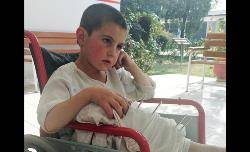Wheeling himself out of the children's ward of Kabul's Emergency Surgical Centre for War Victims, Qasem appeared unmoved by the autumn sun and flowers he turned his wheelchair to face.
"I'll never get better," the seven-year-old from Ghazni province said as his left leg protruded from the red-and-black wheelchair he has been relegated to since stepping on an improvised explosive device weeks earlier.
Despite his disillusionment, the fact that Qasem was able to make it from his home in the eastern province to Kabul's emergency center bodes well for him. Patients at the Italian-run hospital, which is dedicated to treating victims of war-related violence, have a high recovery rate.
"He will get better. It will take time, several months, but he will be able to walk again," Luca Radaelli, the hospital's medical coordinator, told Al Jazeera.
Having stepped on the explosive in early October, Qasem now represents one of the grim statistics on civilian casualties in Afghanistan's 13-year war. A United Nations report on the protection of civilians released on Saturday cited a 14 percent nationwide jump in casualties in 2013.
Like Qasem, 34 percent of civilian deaths and injuries reported by United Nations Assistance Mission in Afghanistan were caused by improvised explosive devices (IEDs) - the conflict's deadliest killer of noncombatants.
Thirty-six percent of the dead and wounded were children. It was the deadliest year for women and children since 2009.
"These people, women and children, represent the most vulnerable groups who are being caught in the crossfire of the conflict," the center's head nurse Tijana Maricic told Al Jazeera.
Surge in casualties
The figures for 2013 are eye-opening: 2,959 killed and 5,656 wounded. The figures came close to 2011's record numbers of 3,133 civilian deaths and 4,706 injuries.
Since 2007 - the year the UN began documenting civilian casualties in the Afghan conflict - more than 17,500 civilians have died.
In Kabul, Qasem was one of several patients being treated for explosive-related wounds. Only a few meters from him, five young women also from Ghazni, were receiving medical care after their car drove over a deadly device.
The UN report said anti-government forces were responsible for 74 percent of civilian casualties in 2013. The Taliban, meanwhile, again described claims about its role in the violence as Western propaganda.
"These reports are produced by the US embassy and then published under the name of United Nations," the Taliban said in a statement, adding it has gone to great lengths to limit civilian casualties.
The Taliban has its own definition of "civilian", which excludes those they believe are linked to the Afghan government or foreigners.
According to the UN report, about 27 percent of all 2013 casualties were the result of fighting between government forces and armed opposition groups. International forces caused about three percent, including those killed during 54 aerial assault operations, the report said.
On treating victims of the conflict, Radaelli said the Emergency center's primary objective is to provide the best treatment possible, especially as the casualty toll continues to rise, but also not to take sides.
He added that the group does not receive financial assistance from the Italian government, which has had troops on the ground in Afghanistan.
"We are here because we are welcome," Radaelli said.
Not taking sides
For the hospital's staff - the majority of whom are Afghan - neutrality dates back to the late 1990s amid fighting between Ahmad Shah Massood's Northern Alliance and the Taliban, led by Mullah Mohammad Omar. By treating the war wounded no matter their affiliation, the Italian non-profit soon won the support of both Massood and Mullah Omar.
In 1999, Massood handed over a former police academy in the Panjshir Valley to the group to turn into a trauma hospital. Mullah Omar soon followed suit, providing a former kindergarten built by the Soviets during their 1979-89 occupation of Afghanistan.
As first-hand responders, Emergency center staff paint a grim picture of the civilian casualty toll in Afghanistan. Despite the operation of 40 first-aid stations and a hospital in the southern province of Helmand, Radaelli said the situation for civilians "has gotten much worse since 2010".
Since then, Emergency has seen a 40 percent annual increase in admissions, he said, and in the capital the rate has increased by 70 percent.
Lashkar Gah, the provincial capital of Helmand, has witnessed a civilian casualty surge of 174 percent in the three years since 2010.
Despite the uptick in cases, the Emergency center operates with the same facilities it has had since 2010 - 97 beds, one intensive care unit and two operating theatres in Kabul.
Staff say resource constraints are accentuated because many patients come for treatment from other hospitals - both government-run facilities and those operated by foreign forces - where they do not receive adequate care.
"By the time they reach our hospital it may already be too late," Maricic said.
With only one percent of Afghanistan's 2014 budget allocated to healthcare, the issue of a lack of adequate medical facilities is likely to increase.
Radaelli said the group will continue to provide care for wounded Afghans even after this year's withdrawal of international troops.
"We were here during the 1999 bombings. We will be here after 2014. America or not, it makes no difference for us," he said.
PHOTO CAPTION
Seven-year-old Qasem was recently wounded by an improvised explosive device in eastern Ghazni province.
Source: Aljazeera


 Home
Home Discover Islam
Discover Islam Quran Recitations
Quran Recitations Lectures
Lectures
 Fatwa
Fatwa Articles
Articles Fiqh
Fiqh E-Books
E-Books Boys & Girls
Boys & Girls  Articles
Articles










